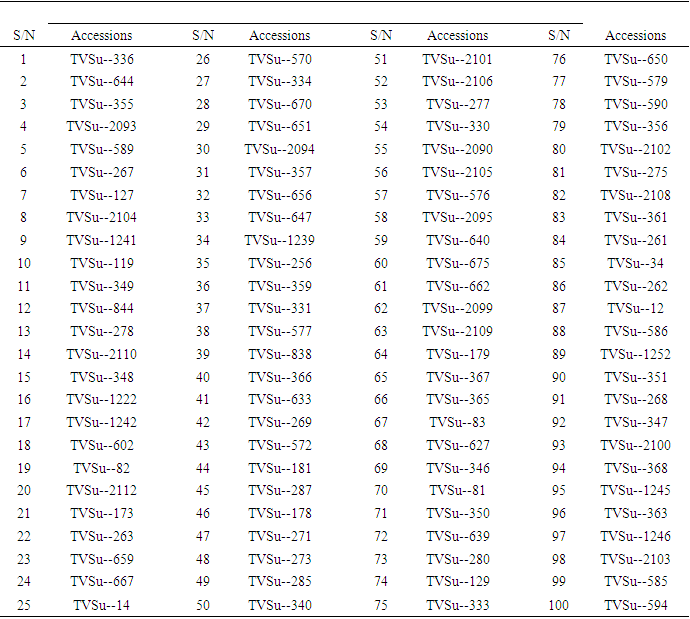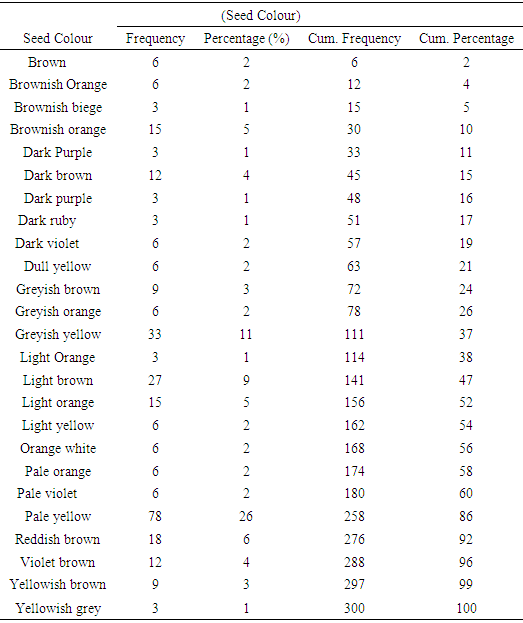-
Paper Information
- Paper Submission
-
Journal Information
- About This Journal
- Editorial Board
- Current Issue
- Archive
- Author Guidelines
- Contact Us
International Journal of Plant Research
p-ISSN: 2163-2596 e-ISSN: 2163-260X
2023; 13(1): 24-42
doi:10.5923/j.plant.20231301.02
Received: Feb. 17, 2023; Accepted: Mar. 15, 2023; Published: Apr. 23, 2023

Morphological Diversity of Some Nigerian Accessions of Bambara Groundnut (Vigna subterranea)
Opeyemi T. Osundare1, 2, Benjamin O. Akinyele3, Alexander C. Odiyi3, Olaniyi A. Oyatomi2, Rajneesh Paliwal2, Michael T. Abberton2
1Department of Crop Science and Horticulture, Federal University Oye-Ekiti, Ekiti State, Nigeria
2Genetic Resources Center, International Institute of Tropical Agriculture, Ibadan, Nigeria
3Department of Crop, Soil and Pest management, Federal University of Technology, Akure, Nigeria
Correspondence to: Opeyemi T. Osundare, Department of Crop Science and Horticulture, Federal University Oye-Ekiti, Ekiti State, Nigeria.
| Email: |  |
Copyright © 2023 The Author(s). Published by Scientific & Academic Publishing.
This work is licensed under the Creative Commons Attribution International License (CC BY).
http://creativecommons.org/licenses/by/4.0/

Increasing effort in the selection of genotypes with superior and desired traits is important for crop improvement, to achieve food and nutritional security in the increasing world population. Hence, this study evaluated the morphological diversity of some Nigerian accessions of Bamabara groundnut. Field experiments were conducted in Nigeria for three years in two locations to assess phenotypic variation of Bambara groundnut accessions based on morphological traits in 2017. Randomized complete block design (RCBD) was used in the evaluation of the selected accessions for three years. Twenty-eight quantitative and ten qualitative traits were observed and subjected to statistical analysis using SAS, version 9.4 software. Twenty-three out of the twenty-eight quantitative morphological traits showed significant differences. TVSu-589 and TVSu-670 had the highest plant height, TVSu-572, TVSu-271 and TVSu-336 had the highest 100-seed weight. Qualitative traits analysis also showed variation. Principal component analysis (PCA) showed PC1 constituting 23.36% and PC2 constituting 15.76% of total variation, while the first eight PCs with eigen values ≥ 1 revealed 77.28% of the total variation. Cluster analysis grouped the selection into four groups. Based on yield data in this study, accessions TVSu-594, TVSu-350, TVSu-336, TVSu-1242, TVSu-129, TVSu-14, TVSu-179, TVSu-2100, TVSu-261, and TVSu-589 were the best for yield and are recommended for further evaluation to improve yield. This study showed that wide range of diversity exists in Bambara groundnut of Nigerian origin that could be useful for further utilization of genetic resources and improvement.
Keywords: Cluster analysis, Nigerian accessions, Bambara groundnut, Vigna subterranea
Cite this paper: Opeyemi T. Osundare, Benjamin O. Akinyele, Alexander C. Odiyi, Olaniyi A. Oyatomi, Rajneesh Paliwal, Michael T. Abberton, Morphological Diversity of Some Nigerian Accessions of Bambara Groundnut (Vigna subterranea), International Journal of Plant Research, Vol. 13 No. 1, 2023, pp. 24-42. doi: 10.5923/j.plant.20231301.02.
Article Outline
1. Introduction
- Bambara groundnut has the potential to improve nutrition, boost food security, foster rural development and support sustainable land use. Bambara groundnut is indigenous to sub-Sahara Africa where it is widely cultivated. The centre of origin is North-Eastern Nigeria, in West Africa [1,2]. This plant is referred to as a ‘groundnut’ because of the way it sets its pods, which is similar to groundnut (Arachis hypogea). The seeds of Bambara groundnut are consumed in several ways and at different stages of maturation, as snack or vegetable. The young fresh seeds may be boiled and eaten as a snack in a manner similar to boiled peanut, and are made into a pudding (or steamed-paste) called Moi-Moi or Okpa (bean porridge) in some parts of Nigeria [3]. In Zambia, Bambara groundnut is used for bread making [4], and to produce legume milk [5]. Dried seeds can be roasted and eaten as confectionery. For centuries, Bambara groundnut germplasm has been maintained as landraces, which are often phenotypically and genetically diverse [6]. All cultivated Bambara groundnut genotypes are from farmers’ mass selection from landraces that have evolved directly from their wild relatives, and which have adapted to the natural environments [7]. Osundare et al. [8] reported that domesticated Bambara groundnut (Vigna subterranean var. subterranea) originated from its wild relative (V. subterranea var. spontanea) through a series of gradual natural and artificial selections that are still taking place. One example of such selection is a change from a spreading / trailing to a bunching growth habit, and reductions in leaflet area, pod thickness and days to flowering as a result of domestication. Adaptation to harsh environmental conditions and yield stability are characteristics that made landraces of Bambara groundnut farmers-friendly [9]. The Bambara groundnut landraces can be systematically exploited in breeding programmes through a dedicated pre-breeding programme. Selection for genotypes will continue in mitigating the effects of climate change and enhancing the responsiveness of the crop to drought. Rex Bernardo [9] also reported that selection of good parents is a key to success in plant breeding. This study provided more estimation of morphological diversity as well as traits that are more diverse and considerable for further evaluation to improve the crop. Hence, this research assessed agronomic variability of 100 Nigerian bambara groundnut accessions by means of 28 quantitative and 10 qualitative agro-morphological traits. The study of the agronomic variability of these accessions could be interesting as a first step toward bambara breeding programme establishment in Nigeria.
2. Materials and Methods
2.1. Plant Material and Experimental Location
- The study was carried out at the International Institute of Tropical Agriculture (IITA), Ibadan, Nigeria and its research station, located at the Institute of Agricultural Research and Training (IAR&T) Ikenne, Nigeria for three years (2017/2018, 2018/2019 and 2019/2020). Ibadan is located on coordinate’s 7.38°N and 3.94°E and it is situated at 181 meters above sea level. The average annual temperature is 26.5°C and about 1311 mm of precipitation falls annually with 81% mean relative humidity. Ikenne is on coordinate’s 6.87°N and 3.71°E and 235.2 meters above sea level, has an annual rainfall of 1200 mm, 65% mean relative humidity and 21.4°C mean temperature respectively. Seeds of one hundred accessions of Bambara groundnut (Table 1) were collected from the list of Genetic Resources Center (GRC), of IITA in 2017 and used for the field experiments. The accessions were previously reported in Osundare et al. [10]. The accessions were selected to guide future research in the selection of genetic resources with thoroughly catalogued agronomic and genomic traits linked to genebank accessions, and to make data publicly available. The selection was also made to identify which of the thousands of the accessions in a database is high yielding, as a critical step in food security.
|
2.2. Experimental Design and Field Management
- The experiments were laid out in a Randomized Complete Block Design (RCBD) with three replications. Total block size was (21 m × 50 m) and each plot was 1 m × 2.5 m. Inter and intra row spacing was 1.00 m and 0.25 m. One seed was hand sown per hole, seed germination count was carried out and supply was done two weeks after planting. Systemic and pre-emergence herbicide (Metaforce with active ingredient (a.i.) Metolachlor E.C) and contact herbicide (Paraeforce a.i. paraquat) were used to control weed at the rate of 200 milligram per 20 liters.
2.3. Data Collection
- Twenty eight quantitative traits were collected using the descriptor for Bambara groundnut [11] (Table 2). The experimental unit consisted of 10 plants per replicate. Data on the traits from the replicated trials were generated using five tagged plants (at the middle of the row). Ten qualitative traits were collected as follows; terminal leaflet colour, terminal leaflet shape, petiole colour, pod shape, dry pod colour, seed shape, growth habit, open flower colour, seed hilum colour, and eye pattern as guided by the descriptor for Bambara groundnut [11].
 | Table 2. Quantitative traits observed on Bambara groundnut accessions |
2.4. Data Analysis
- Data collected in the three replications of the two locations and in the three years across locations were averaged and computed for all accessions, then subjected to analysis of variance (ANOVA) using the PROC GLM procedure on statistical analytical system (SAS, version 9.4) [12]. Treatment means were compared using Duncan multiple range test (DRMT) at 5% and 1% to separate the significant differences. Mean squares were used to estimate the varying component for each characteristic. Principal Component Analysis (PCA) was carried out using the PROC PRINCOMP procedure on SAS to determine the contribution of each trait to the total variation observed on the accessions used. Cluster analysis was carried out using PROC CLUSTER procedure (Ward hierarchical clustering method) to show the distribution of the accessions into their different groups. Descriptive statistics was also employed to analyze qualitative data using frequencies and percentages. Pearson correlation was used to determine the relationships among the traits using PROC CORR in the SAS program.
3. Results
3.1. Quantitative Traits
- The analysis of variance revealed highly significant (P≤0.01) differences for most of the quantitative traits studied (Table 3) in the three years for twenty-three traits, out of the twenty-eight quantitative traits evaluated. Such traits that varied significantly among accessions in the three years include; plant height, terminal leaflet length (mm), terminal leaflet width (mm), number of trifoliate leaves, petiole length, 100-seed weight, plant spread, internode length, banner length, peduncle length, number of days to first flowering, number of days to 50% flowering, number of flower per peduncle, yield per plant, number of pods per plot, yield per plot, yield per hectare, number of seed per pod, pod length, pod width, seed length, seed width, shell thickness. The mean value of the accessions studied revealed that Plant height (PH, cm) varied significantly from 28.85 to 18.27, while accessions TVSu-589, TVSu-670, TVSu-2109, TVSu-2106, TVSu-285 had the highest plant height and accessions TVSu-1239, TVSu-662 and TVSu-647 had significantly short plant height. Terminal leaflet length (TLL, mm) varied significantly from 84.14 to 45.33, accessions TVSu-589, TVSu-2109, TVSu-2106, TVSu-2105, TVSu-285 had longest terminal leaflet length while accessions TVSu-662, TVSu-838, TVSu-275 and TVSu-1252 had shortest terminal leaflet length. Terminal leaflet width (TLW, mm) varied significantly from 44.97 to 19.79, accessions TVSu-2109, TVSu-589, TVSu-2105, TVSu-2106 had widest terminal leaflet width while accessions TVSu-586, TVSu-647, TVSu-14 and TVSu-365 had significantly narrow terminal leaflet width. Petiole length (PetL, mm) varied significantly from 205.88 to 116.88, accessions TVSu-670, TVSu-589, TVSu-2109, TVSu-2100, TVSu-331had longest petiole length while accessions TVSu-1239, TVSu-662, TVSu-2112, TVSu-647 had shortest petiole length. Number of trifoliate leaves (NTLs) varied significantly from 95.04 to 49.97, accessions TVSu-333, TVSu-838, TVSu-1242, TVSu-1245, TVSu-633 had the highest number of trifoliate leaves while accession TVSu-269, TVSu-627, TVSu-127, TVSu-675, TVSu-173 had lowest number of trifoliate leaves. Plant spread (PlanSpr, cm) varied significantly from 45.71 to 28.85, accessions TVSu-271, TVSu-2109, TVSu-2105, TVSu-331, TVSu-2099 covered the widest area of land while accessions TVSu-365, TVSu-647, TVSu-348, TVSu-1222 covered narrow area of land. Internodes length (IL, mm) varied significantly from 22.96 to 10.45, accessions TVSu-129, TVSu-589, TVSu-2106, TVSu-2109, TVSu-572 had the longest internodes length while accessions TVSu-173, TVSu-650, TVSu-577, TVSu-261 had shortest inter nodes length. Banner length (BL, mm) varied significantly from 5.98 to 5.25, accessions TVSu-590, TVSu-346, TVSu-2104, TVSu-348, TVSu-585 had the longest banner length while accessions TVSu-1252, TVSu-662, TVSu-334 and TVSu-576 had shortest banner length. Peduncle length (PdclL, mm) ranged from 6.58 to 3.98, accessions TVSu-670, TVSu-1241, TVSu-2112, TVSu-589, TVSu-647 had the longest peduncle length while accessions TVSu-662, TVSu-2102, TVSu-656, TVSu-271 and TVSu-178 had shortest peduncle length. Number of days to first flowering observed among the selected accessions was 34-41 days and number of days to maturity was 116-131 days. Pod length (PdL, mm) ranged from 24.68 to 14.96, accessions TVSu-2105, TVSu-589, TVSu-2109, TVSu-336, TVSu-2100 had the longest pod length while accessions TVSu-639, TVSu-640, TVSu-662 and TVSu-269 had shortest pod length. Pod width (PdW, mm) ranged from 15.79 to 10.43, accessions TVSu-572, TVSu-368, TVSu-2099, TVSu-366, TVSu-271 had the widest pod width while accessions TVSu-365, TVSu-662, TVSu-269 and TVSu-659 had narrow pod width. Grain yield per hectare (GYpHa, Kg) ranged from 1091.80 to 416.20, accessions TVSu-594, TVSu-261, TVSu-336, TVSu-350, TVSu-1242 had the highest yield per hectare while accessions TVSu-285, TVSu-659, TVSu-359, TVSu-268 had lowest grain yield per hectare. Hundred seed weight (100-sdwt, g) ranged from 121.52 to 40.18, accessions TVSu-572, TVSu-271, TVSu-336, TVSu-368, TVSu-83 had the highest 100-seed weight while accessions TVSu-287, TVSu-263, TVSu-178, TVSu-586, TVSu-662 had lowest 100-sdwt. Exceptional accessions with high yielding characteristics above 800kg per hectare in the locations and years include (TVSu-594 (1091.80), TVSu-261 (966.20), TVSu-336 (917.80), TVSu-350 (903.30), TVSu-1242 (877.30), TVSu-2100 (855.40), TVSu-179 (848.20), TVSu-14 (834.30), TVSu-589 (820.70), TVSu-129 (819.30) (Table 4).
 | Table 3. Mean squares of ANOVA for quantitative traits of Bambara groundnut in two locations for three years |
 | Table 3. cont’d Mean squares of ANOVA for quantitative traits of Bambara groundnut in two locations for three years |
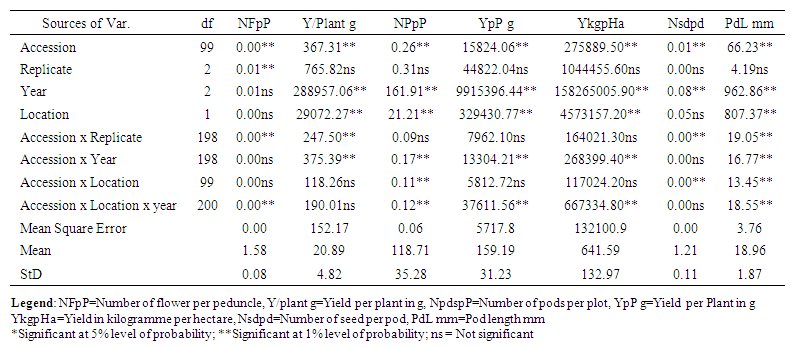 | Table 3. cont’d Mean squares of ANOVA for quantitative traits of Bambara groundnut in two locations for three years |
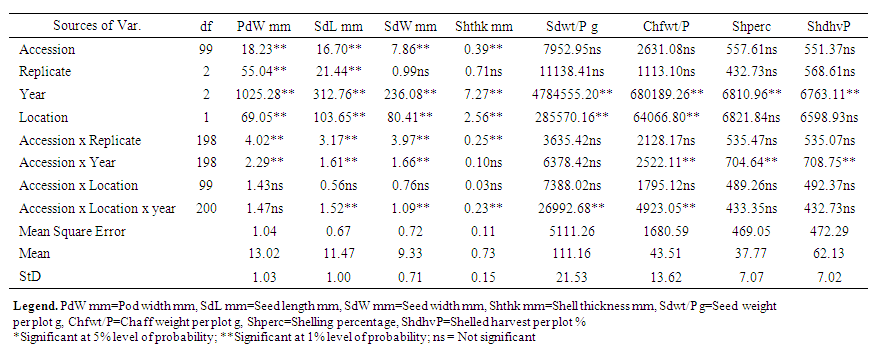 | Table 3. cont’d Mean squares of ANOVA for quantitative traits of Bambara groundnut in two locations for three years |
 | Table 4. Mean performance of selected yield traits of 100 accessions of Bambara groundnut for three years (2017/2018, 2018/2019 and 2019/2020) |
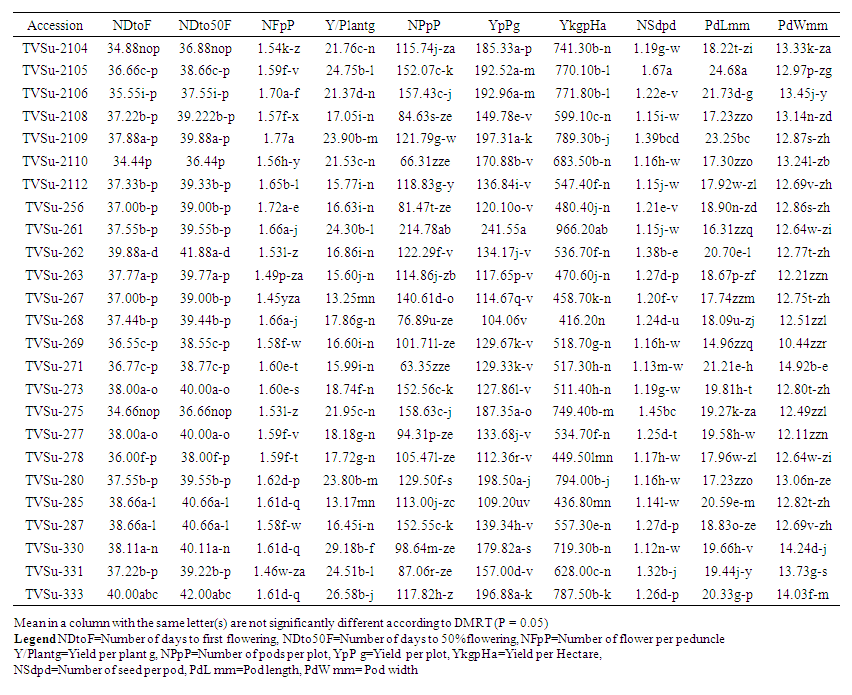 | Table 4. cont’d. Mean performance of selected yield traits of 100 accessions of Bambara groundnut for three years (2017/2018, 2018/2019 and 2019/2020) |
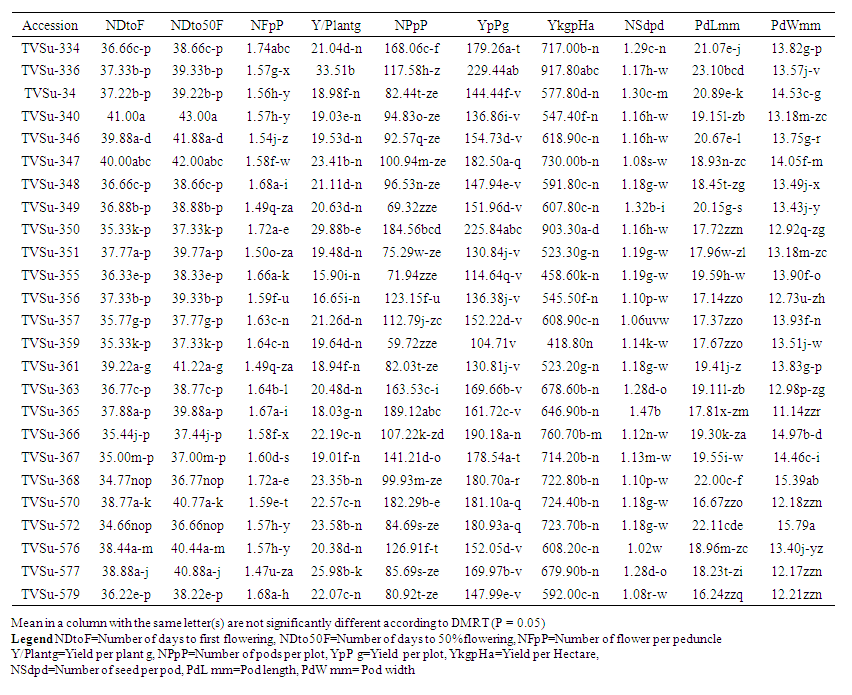 | Table 4. cont’d. Mean performance of selected yield traits of 100 accessions of Bambara groundnut for three years (2017/2018, 2018/2019 and 2019/2020) |
 | Table 4. cont’d. Mean performance of selected yield traits of 100 accessions of Bambara groundnut for three years (2017/2018, 2018/2019 and 2019/2020) |
3.2. Principal Component
- Comparison of the PC’s contribution to diversity in the three years revealed Principal components 1-8 constitute 77.28% of the total variation, where PC 1, 2, 3, 4, 5, 6, 7 and 8 contributed (23.36%, 15.76%, 12.22%, 6.86%, 6.17%, 4.72%, 4.34% and 3.85%) respectively. Principal component analysis showed PC1 constituted 23.36% and PC2 constituted 15.76%, while the first eight PC’s had eigen values ≥1 revealed 77.28% of total variation. Higher contribution to total variation was revealed by PC’s 1 and 2. PC1 contributed 23.36%, containing plant height (0.28), terminal leaflet length (0.26), terminal leaflet width (0.26), petiole length (0.24), plant spread (0.25), internode length (0.19), yield per plant (0.19), yield per plot (0.19), pod length (0.28), pod width (0.29), seed length (0.30), seed width (0.24), 100-seed weight (0.28). These components contributed positively to total variation.PC2 contributed 15.76%, yield per plant (0.29), number of pods per plot (0.34), yield per plot (0.38), yield per hectare (0.38), seed weight per plot (0.40), shelled harvest per plot (0.31) while shelling percentage (-0.30) contributed negatively (Figure 1) (Table 5).
 | Figure 1. Contribution of PC1 and PC2 to variation |
 | Table 5. Eigen values and contribution of first eight principal components axes to variation in 2017/2018, 2018/2019 and 2019/2020 |
3.3. Qualitative Traits
- Descriptive statistics on qualitative traits observed on terminal leaflet colour, growth habit and open flower colour were uniform in all the studied accessions. The analysis of Terminal leaflet shape (TLS) revealed that 55% of the selected accessions are ‘lanceolate’, 44% ‘oval’ and 1% ‘elliptic’. The analysis of Petiole colour showed that 66% had ‘whole green’ petiole while 34% had ‘base purple’ petiole colour. The analysis of Pod shape revealed that 57% had ‘ending in a point with nook on the other side’ while 41% had ‘ending in a point round on the other side’ while others also exited. The analysis of Dry pod colour revealed that 82% had ‘yellowish brown’ dry pod colour while 13% had ‘brown” dry pod colour, while others also existed. The analysis of Seed shape revealed that 89% had ‘oval’ seed shape while 11% had ‘round’ seed shape. The analysis of Seed hilum colour showed that 51% had ‘white’ seed hilum colour while 49% had ‘chalk white’ seed hilum colour. The analysis of Eye pattern showed that ‘cream testa with grey butterfly-like eye’ was highest with 21% while ‘cream testa with brown butterfly-like eye’ accounted for 16% of the selected accessions, while others also existed (Table 6). The analysis of seed colour revealed that Twenty-six percent (26%) had pale yellow colour, eleven percent (11%) had greyish yellow, nine percent (9%) had light brown, six percent (6%) had reddish brown, five percent (5%) had light orange, five percent (5%) had brownish orange, four percent (4%) had dark brown, four percent (4%) had violet brown, three percent (3%) had grayish brown, three percent (3%) had yellowish brown, two percent (2%) had light yellow, two percent (2%) had orange white, two percent (2%) had pale violet while others had less than two percent (2%) occurrence (Table 6). Plate 1 show seed colours and eye patterns of some selected accessions and plate 2 showed the layout of the experimental field.
|
|
|
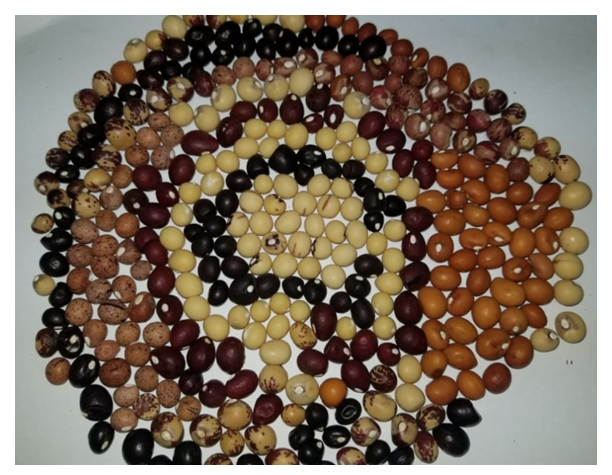 | Plate 1. Selected Bambara groundnut accessions showing seed colour and eye pattern |
 | Plate 2. Bambara groundnut field in one of the locations |
3.4. Correlation Coefficients
- Correlation coefficients revealed that plant height had positive and significant correlation with yield per plant, yield per plot, yield per hectare, pod length, pod width, seed length, seed width, 100-seed weight. Number of days to first flowering had negative and significant correlation with yield per plot, yield per hectare, pod width, seed width, seed weight per plot, and 100-seed weight. Yield per plant had positive and significant correlation with number of pods per plot, yield per plot, yield per hectare, pod length, pod width, seed length, seed width, seed weight per plot, and 100-seed weight. Number of pod per plot had positive and significant correlation with yield per plot, yield per hectare, number of seed per pod, seed weight per plot, shelled harvest per plot, but had negative and significant correlation with pod width, seed width, shelling percentage, and 100-seed weight. Yield per plot had positive and significant correlation with yield per hectare, pod length, pod width, seed length, seed width, seed weight per plot, chaff weight, shelled harvest per plot, and 100-seed weight. Yield per hectare had positive and significant correlation with pod length, pod width, seed length, seed width, seed weight per plot, chaff weight, shelled harvest, 100-seed weight, but had negative and significant correlation with shelling percentage. Number of seed per pod had positive and significant correlation with pod length but had negative and significant correlation with pod width, seed width, and 100-seed weight. Pod length had positive and significant correlation with pod width, seed length, seed width, and 100-seed weight. Pod width had positive and significant correlation with seed length, seed width, shelling percentage, 100-seed weight, but had negative and significant correlation with shelled harvest. Seed length had positive and significant correlation with seed width, seed weight per plot, and 100-seed weight. Seed width had positive and significant correlation with 100-seed weight. Seed weight per plot had positive and significant correlation with shelled harvest per plot, and 100-seed weight but had negative and significant correlation with shelling percentage. Chaff weight had positive and significant correlation with shelling percentage, 100-seed weight but had negative and significant correlation with shelled harvest per plot. Shelling percentage had negative and significant correlation with shelled harvest per plot.
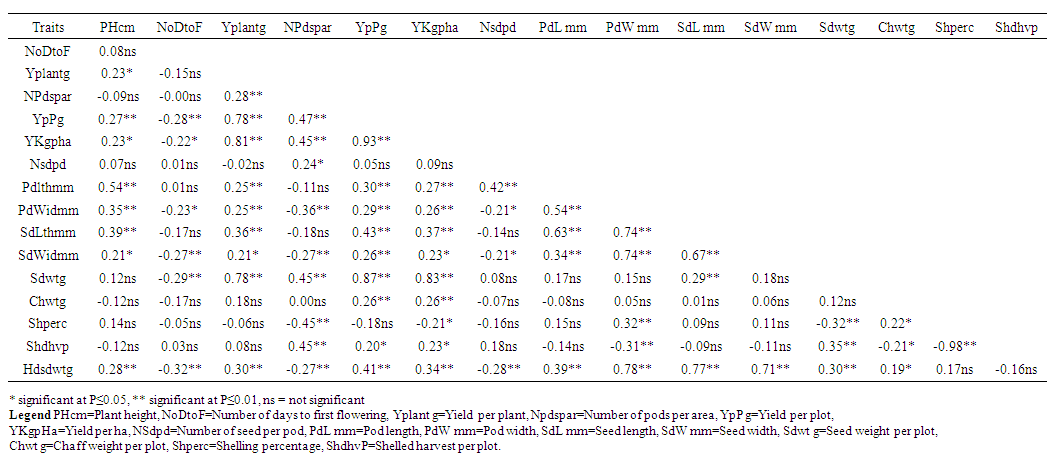 | Table 7. Combined phenotypic correlation of yield contributing traits evaluated in Ibadan and Ikenne for three years |
3.5. Cluster Analysis of Quantitative Traits
- Cluster analysis was used to assess the genetic differences of the observed quantitative traits, where individuals with related descriptions are grouped into the same cluster. The similarity, relatedness, and distance of the varieties are the foundation of this method, where similar accessions were grouped into the same cluster, and dissimilar accessions were grouped differently. The length between the lines (distance between two points) was calculated using standardized morphological data, and dendrogram was constructed using these values (Figure 2). The selected population was grouped into four subpopulations, cluster 1 had 9 accessions, cluster 2 had 41 accessions and cluster 3 had 16 accessions and cluster 4 had 34 accessions (Table 8) (Figure 2). Accession with the highest yield components and highest agronomic traits responses fell into cluster 2 and cluster 4 as revealed through the means.
|
4. Discussion
- The highly significant differences observed on the quantitative traits indicated the presence of genetic variation among the accessions studied. [13, 14, 15, 16 and Odongo et al. [17] reported morphological variations of the quantitative and qualitative traits of Bambara groundnut accessions studied. Tafadzwanashe and Albert [18,19] also reported variation in plant height, number of leaves, number of days to first flowering and number of days to 50% flowering. Shegro et al. [15] and [20,21,22] also reported variation in number of pods per plot among the accessions studied, this could be due to the heterogeneity existing among Bambara groundnut accessions. The earliness and variation in number of days to first flowering and number of days to maturity indicated the selected accessions for this study could be selected for early maturity. Similar trend of early maturity in Bambara groundnut was also reported [15,16,21] flowering ranged from 32 to 42 days after sowing, later days to flowering had been reported [2] in Northern, Cote d’Ivoire for late maturing accessions of Bambara groundnut. Number of seed per pod revealed higher percentage of the pods was single seeded compared to double seeded pod [23]. Variation observed on the number of days to flowering, might be due to genotypic factors or influence of environmental conditions such as day length duration that prevailed during the crop growth and development. No significant difference in the number of days to maturity among the accessions, which indicated that vagaries of weather may fasten the maturity period of Bambara groundnut or might have been among the group of early maturing ones. Berchie et al. [24] observed no significant difference in the number of days to maturity. Earliness to maturity may be a veritable tool to escape drought in erratic heightening moisture stress environment and insect infestation [25,26]. Yield per plant varied significantly among the selected accessions, locations and in the years, indicating that yield of Bambara groundnut varied widely depending on accessions and environmental conditions. Similar result was reported by Khan et al. [27]. Yield per hectare also revealed significant differences among the accessions in the observed years with an average of 641.59 kg per hectare. This confirmed the report of Khan [28] that Bambara groundnut can grow and produce reasonable yield in Africa [27,37]. PC1 and PC2 had the highest contribution to variation, indicating that the component traits in PC1 and PC 2 are key factors to reveal diversity in the selected accessions. Similar results were also reported by Ntundu et al. [13,28,29] that vegetative traits had prominent loadings in principal components analysis [30]; Mohammed et al. [31] reported diversity on seed morphological features; this might be valuable to generate baseline seed morphology revealing diversity of the crop. Variation observed in yield and agronomic traits such as 100-seed weight yield per plant, plant height indicated that diversity existed in the accessions used for this study as revealed by different clusters. This also indicated that accessions within the same cluster possess similar morphological traits. The level of morphological similarity showed by accessions within the same cluster indicated that the accessions may not have common ancestry. Similar results were reported [13,14] and Mohammed et al. [21] on Bambara groundnut. The analysis of ‘Locations’ showed significant variations for twenty out of the twenty eight traits evaluated in the years, meaning that locations have significant effect on the traits and such traits may be more reliant on genetic expression as influenced by environmental conditions. Similar result was obtained by Esan et al. [33] reported significant differences on traits of Bambara groundnut evaluated in different regions in Cote d’Ivoire. Yield per plant varied significantly among accessions in the years from 12g/plant – 42g/plant, indicating that the yield of Bambara groundnut varied widely depending on accessions and environmental conditions. Shareef et al. [34,25,35] also reported reasonable yield of Bambara groundnut accessions with minimal input, low rainfall and poor soil fertility. Chai et al. [35,36,37] further reiterated that Bambara groundnut are drought resistant compared to other crops but that yields are highly affected by water stress and even moderate water stress can cause high yield losses. Morphological variation as revealed in the ‘Years’ had significant effects on observed traits. Similar result was reported by Hlanga et al. [6,33,38].The interaction of ‘Accession by location’ also indicated that traits responsible for diversity in Bambara groundnut showed significant differences in the locations. This was also reported by Muhammad et al. [7]. Some of the non-significant quantitative traits are less influenced by location and may express their genetic potentials at any particular location. The interaction of ‘Accession by location by year’ showed that accessions of Bambara groundnut express it morphological traits differently in locations, hence, diversity among the ‘accessions’ is genetically and environmentally controlled.
5. Conclusions
- This study concluded that morphological variability existed among Bambara groundnut in Nigeria and that such variation existed in plant height, petiole length, pod width, plant spread, yield per hectare, yield per plot, yield per plant, number of pods per plot, terminal leaflet length, number of days to first flowering and number of days to 50% flowering and are important traits that should be given attention in making effective selection for parents in Bambara groundnut breeding. This study confirmed that positive correlation existed among yield contributing traits and yield per hectare. Furthermore, the dendrogram showed that the selected population was divided into four primary clusters based on the observed quantitative traits. Accessions TVSu-594, TVSu-350, TVSu-336, TVSu-1242, TVSu-129, TVSu-14, TVSu-179, TVSu-2100, TVSu-261, and TVSu-589 had the best in terms of yield and yield components based on yield data in this study, and should be given attention in future breeding programmes in other ecological zones in Nigeria. Further studies should also make use of high throughput sequencing markers to dissect the level of diversity established in this study in the genomic constituent of Bambara groundnut.
Funding
- This research was financed by The Global Crop Diversity Trust (Crop Trust), through the Consultative Group on International Agricultural Research (CGIAR) and the Genetic Resources Center, International Institute of Tropical Agriculture, Ibadan, Nigeria.
ACKNOWLEDGEMENTS
- Special thanks to the Genetic Resources Center, International Institute of Tropical Agriculture, Ibadan, Nigeria for the research fellowship awarded, in the course of carrying out this research.
Conflict of Interest
- The authors declare that we have no conflict of interest.
 Abstract
Abstract Reference
Reference Full-Text PDF
Full-Text PDF Full-text HTML
Full-text HTML